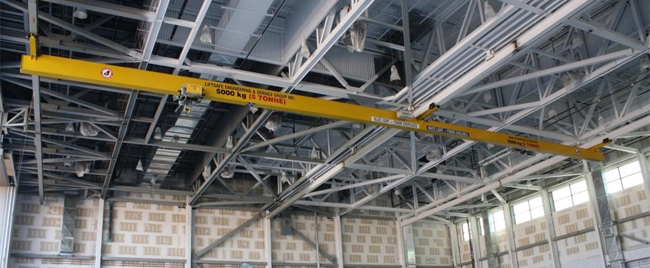Related: Overhead Cranes, Jib Crane & Workstation Bridge Cranes
Many companies in different industries utilize overhead cranes to help speed up production.
Space is a precious thing for many companies, often times they are already dealing with having a tight fit, which is why an overhead crane can make all of the difference. These heavy-duty machines allow for one to be able to carry a load across the length and width of the building and drop it off at the correct location (which is often served by its own light-duty crane).
A common type of overhead crane that is often used in manufacturing is the overhead bridge crane. These high powered operating machines run on elevated tracks and are often the preferred choice because it allows for a hook motion along three axes (up & down, back & forth and side to side). These cranes can run either on top of girders or be under-hung.
A gantry crane is operated like an overhead crane, though these cranes are supported on the floor and are connected to either a set of tracks or four wheels. These cranes are extremely helpful when it comes to loading items to be transported in between buildings.
A jib crane is another common machine, which is found with overhead cranes. These cranes have a pivoting head and a boom assembly, which the hoist then becomes attached. These cranes can be either attached to the floor or building column.
Classifications
Now that we have covered the general knowledge of the different cranes most often found in a manufacturing environment let us move on. The Crane Manufacturers Association of America or CMAA has a classification system for cranes based upon the stats per hour and the average percentage of full capacity being lifted (you may remember something similar being discussed during our blogs about inspections).
These classifications include the following:
Class A: Standby or Infrequent Service
Class B: Light Service
Class C: Moderate Service
Class D: Heavy Service
Class E: Severe Service
Class F: Continuous Severe Service
Class A cranes are typically installation and maintenance cranes, they work as slow speed material handling devices; these are often cranes that idle for long periods between lifts.
Classes C and D cover the major of equipment used in the metal processing industry, often handling loads that average around 50% of their rated capacity.
Class F covers cranes such as top-riding bridge and gantry-type, multiple-girder, electric overhead and travelling cranes. These cranes are capable of handling loads that approach the rated capacity of the crane and do so for the vast majority of their working life.
Safety Considerations
The golden rule when using overhead cranes is to never bring a load over someone’s head.
The second-best rule is to ensure that all of your operators are fully trained on how to use the crane, to often companies do not wish to spend the time or money needed to train a crane operator properly.
What Needs to Happen Before a Crane Install?
The first of these questions need to be considered:
What will the crane be moving?
How often will the crane be used?
How will the crane be supported?
What is the clearance level (distance between the floor and lowest point in the building ceiling)?
How high do you need the crane to lift?
These questions are very important when a company starts to look at possible future needs. You may get a crane that works for your needs perfectly today, but it may be unsuitable in the future. This is why when you pick out a crane you need to keep in mind the future load requirements of the crane.
Overhead cranes can be a huge boon to your business, by decreasing both the time and space it takes to move components from one location to the next. But it is extremely important to be aware of what to look out for when buying, maintaining and operating your overhead crane. You want to make sure that this large investment will last for years to come.
Have you ever operated an overhead crane?
What advice do you have for someone looking for an overhead crane?
Share your comments below!


